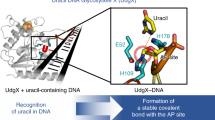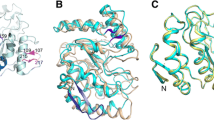Abstract
ANY uracil bases in DNA, a result of either misincorporation or deamination of cytosine, are removed by uracil-DNA glycosylase (UDG), one of the most efficient and specific of the base-excision DNA-repair enzymes1. Crystal structures of human2,3 and viral4 UDGs complexed with free uracil have indicated that the enzyme binds an extrahelical uracil. Such binding of undamaged extrahelical bases has been seen in the structures of two bacterial methyltransferases5,6 and bacteriophage T4 endonuclease V (ref. 7). Here we characterize the DNA binding and kinetics of several engineered human UDG mutants and present the crystal structure of one of these, which to our knowledge represents the first structure of any eukaryotic DNA repair enzyme in complex with its damaged, target DNA. Electrostatic orientation along the UDG active site, insertion of an amino acid (residue 272) into the DNA through the minor groove, and compression of the DNA backbone flanking the uracil all result in the flipping-out of the damaged base from the DNA major groove, allowing specific recognition of its phosphate, deoxyribose and uracil moieties. Our structure thus provides a view of a productive complex specific for cleavage of uracil from DNA and also reveals the basis for the enzyme-assisted nucleotide flipping by this critical DNA-repair enzyme.
Similar content being viewed by others
References
Lindahl, T. Nature 362, 709–715 (1993).
Mol, C. D. et al. Cell 82, 701–708 (1995).
Mol, C. D. et al. Cell 80, 869–878 (1995).
Sawa, R., McAuley-Hecht, K., Brown, T. & Pearl, L. Nature 373, 487–493 (1995).
Klimasauskas, S., Kumar, S., Roberts, R. J. & Cheng, X. Cell 76, 357–369 (1994).
Reinisch, K. M., Chen, L., Verdine, G. L. & Lipscomb, W. N. Cell 82, 143–153 (1995).
Vassylyev, D. G. et al. Cell 83, 773–782 (1995).
Arnes, B. N., Shigenaga, M. K. & Hagen, T. M. Proc. Natl Acad. Sci. USA 90, 7915–7922 (1993).
Mol, C. D., Kuo, C.-F., Thayer, M. M., Cunningham, R. P. & Tainer, J. A. Nature 374, 381–386 (1995).
Nelson, H. C. M. & Baker, T. H. Chem. Biol. 3, 419–423 (1996).
Kavli, B. et al. EMBO J. 15, 3442–3447 (1996).
Sawa, R. & Pearl, L. H. Nature Struct. Biol. 2, 752–757 (1995).
Slupphaug, G. et al. Biochemistry 34, 128–138 (1995).
Domena, J. D., Timmer, R. T., Dicharry, S. A. & Mosbaugh, D. W. Biochemistry 27, 6742–6751 (1988).
Krokan, H. & Wittwer, C. U. Nucleic Acids Res. 9, 2599–2613 (1981).
Delort, A.-M. et al. Nucleic Acids Res. 13, 319–335 (1985).
Varshney, U. & van de Sande, J. H. Biochemistry 30, 4055–4061 (1991).
Kubareva, E. A. et al. Gene 157, 167–171 (1995).
Otwinowski, Z. Proc. CCP4 Study Weekend January 29–30, 56–62 (1993).
Navaza, J. Acta Cryst. A50, 157–163 (1994).
Brünger, A. T., Kuriyan, J. & Karplus, M. Science 235, 458–460 (1987).
Read, R. J. Acta Crystallogr. A42, 140–149 (1986).
McRee, D. E. J. Mol. Graphics 10, 44–47 (1992).
Engh, R. A. & Huber, R. Acta Cryst. A47, 392–400 (1991).
Davis, M. E. & McCammon, J. A. Chem. Rev. 90, 509–521 (1990).
Author information
Authors and Affiliations
Rights and permissions
About this article
Cite this article
Slupphaug, G., Mol, C., Kavli, B. et al. A nucleotide-flipping mechanism from the structure of human uracil–DNA glycosylase bound to DNA. Nature 384, 87–92 (1996). https://doi.org/10.1038/384087a0
Received:
Accepted:
Issue Date:
DOI: https://doi.org/10.1038/384087a0
- Springer Nature Limited
This article is cited by
-
Molecular Biology Applications of Psychrophilic Enzymes: Adaptations, Advantages, Expression, and Prospective
Applied Biochemistry and Biotechnology (2024)
-
Uracil-DNA glycosylase efficiency is modulated by substrate rigidity
Scientific Reports (2023)
-
CRISPR–Cas9 bends and twists DNA to read its sequence
Nature Structural & Molecular Biology (2022)
-
Generic nature of the condensed states of proteins
Nature Cell Biology (2021)
-
DNA repair glycosylase hNEIL1 triages damaged bases via competing interaction modes
Nature Communications (2021)





